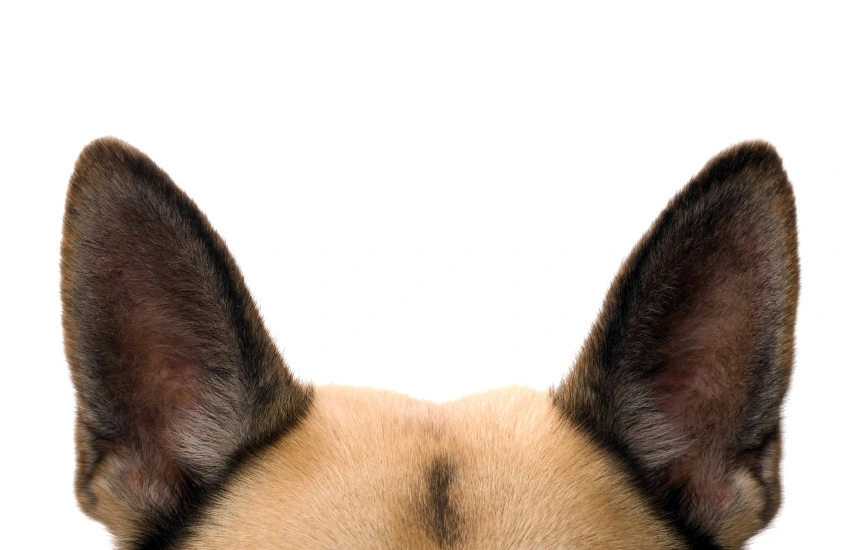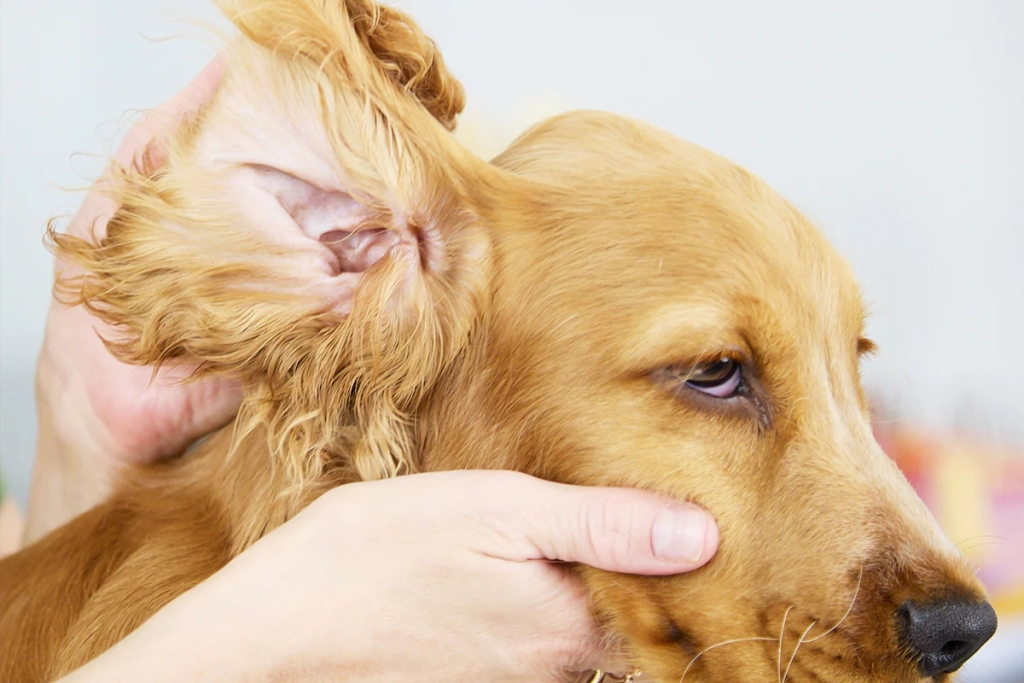134Views

Dog’s Ears: Anatomy, Infection And Caring Tips
The sight of a dog’s ears perked up, listening intently, or the comforting flop of their head during a belly rub – their ears are more than just adorable accessories.
They’re intricate communication tools, temperature regulators, and even mood indicators.
Let’s embark on a fascinating journey into the world of a dog’s ears, uncovering their hidden functions and appreciating their remarkable capabilities.
A World of Shapes and Sizes
From the majestic prick ears of a German Shepherd to the floppy folds of a Basset Hound, each breed boasts unique ear shapes that reflect their origins and purpose.
Prick ears funnel sounds, aiding hunting dogs in detecting prey. Droopy ears like those of Bloodhounds offer protection and trap scent molecules, enhancing their tracking ability.
Even seemingly insignificant details like ear size and thickness can influence hearing sensitivity and heat regulation.
Reading the Folds
A dog’s ears are like tiny billboards, expressing their feelings through subtle changes in position. Perked ears signify alertness and curiosity, while flattened ears might indicate fear or submission.
Tail flicks and ear movements can be read together to paint a clearer picture of your dog’s emotional state. Understanding this “ear language” strengthens your bond and helps you respond to their needs effectively.
Hearing Beyond Our Imagination
Dogs possess superhuman hearing, detecting sounds at higher frequencies and from farther distances than humans.
This ability allows them to hear subtle changes in the environment, like approaching footsteps or distant sirens, making them excellent watchdogs and valuable companions for people with hearing impairments.
Remember, loud noises can be overwhelming for their sensitive ears, so prioritize soundproofing and provide quiet spaces for them to relax.
Temperature Control Through the Flaps
A dog’s ears aren’t just for listening; they play a crucial role in regulating body temperature.
Increased blood flow through the thin skin of their ears helps release heat, especially important for breeds with thick coats or those living in warm climates.
Panting further aids in cooling, so don’t be alarmed if your dog’s ears seem extra floppy on a hot day – it’s their natural air conditioning system at work!
Essential Ear Care

Regular ear cleaning is crucial for preventing infections and maintaining healthy hearing. Use veterinarian-approved ear cleaning solutions and gently wipe the visible ear canal, avoiding deeper insertion.
Droopy ears might require more frequent cleaning due to their increased moisture retention. Be mindful of any unusual odors, redness, or discharge, as these could indicate an ear infection requiring veterinary attention.
Responsible Ear Handling
Remember, a dog’s ears are sensitive and essential sensory organs. Avoid grabbing, pulling, or poking their ears, as this can cause pain and discomfort.
Respect their personal space and approach ear cleaning with gentleness and positive reinforcement.
By appreciating the unique functions and complexities of a dog’s ears, you can forge a deeper bond with your furry friend, understanding their silent communication and ensuring their overall well-being.
So, the next time you see those floppy flaps or perked-up antennas, remember the remarkable world they represent – a world of sound, emotion, and temperature regulation that enriches their lives and ours.
Read More: Dog Nose: An Ultimate Guide
Dog Ear Anatomy: A Guide to the External Folds
The external portion of a dog’s ear, visible to the naked eye, is more than just a cute and floppy appendage.
It’s a complex structure with various parts, each playing a crucial role in hearing, balance, and communication. Let’s delve into the fascinating world of dog ear anatomy, exploring its key components and their functions.
The Pinna: The Most Prominent Feature
The most noticeable part of a dog’s ear is the pinna, also known as the ear flap. Its shape and size vary greatly between breeds, reflecting their unique needs and origins.
For instance, prick ears like those of German Shepherds are designed to funnel sound waves, while the floppy folds of Bloodhounds offer protection and trap scent molecules for enhanced tracking.
The pinna is made of cartilage, a flexible yet sturdy material that supports the ear’s structure. It’s covered by thin skin, richly innervated with nerves, making it sensitive to touch and temperature changes.
Muscles at the base of the pinna allow dogs to rotate and tilt their ears, adjusting their direction to pinpoint sounds and express emotions.
The Ear Canal: The Pathway to Sound
Leading from the pinna to the eardrum is the ear canal, a narrow passage lined with hair and glands.
These hairs help trap dirt and debris, while the glands produce cerumen, commonly known as earwax, which has antibacterial and lubricating properties.
The ear canal plays a crucial role in channeling sound waves towards the eardrum and protecting it from external elements.
The Tragus and Antitragus: More Than Just Bumps
The tragus and antitragus are the small bumps found at the base of the ear canal, often mistaken for purely cosmetic features. However, they play a vital role in sound localization.
The tragus helps funnel sound waves into the ear canal, while the antitragus reflects them, creating a tiny echo that aids in determining the direction of the sound source.
Understanding the Importance of Ear Care
Knowing the external anatomy of your dog’s ears empowers you to provide proper care and prevent potential issues.
Regular cleaning with veterinarian-approved solutions helps remove dirt, debris, and excess wax, preventing infections.
Additionally, be mindful of any unusual discharge, redness, or swelling, as these could indicate an ear infection requiring veterinary attention.
By appreciating the intricate design and functions of your dog’s external ears, you can ensure their optimal hearing, maintain their well-being, and strengthen your bond through a deeper understanding of their unique communication methods.
Dog Ear Infection
If you suspect that your dog has an ear infection, it’s important to seek veterinary attention promptly. Ear infections in dogs can be painful and, if left untreated, may lead to more serious complications.
Here are some signs that your dog may have an ear infection:
- Ear Scratching: Excessive scratching or pawing at the ears is a common sign of discomfort or irritation.
- Head Shaking: If your dog is shaking its head frequently, it may be trying to alleviate the discomfort caused by an ear infection.
- Ear Odor: A foul odor emanating from the ears can be a sign of infection.
- Redness and Swelling: Inflamed or swollen ears, often accompanied by redness, can indicate an infection.
- Discharge: The presence of abnormal discharge, such as pus or a brown, waxy substance, can be a sign of infection.
- Pain or Discomfort: If your dog reacts negatively when you touch or manipulate its ears, it may be experiencing pain.
- Changes in Behavior: A dog with an ear infection may exhibit changes in behavior, such as irritability or lethargy.
If you notice any of these signs, it’s crucial to consult with a veterinarian. The vet will examine the ears, possibly take a sample for analysis, and determine the cause of the infection.
Treatment typically involves cleaning the ears and administering medication, such as topical or oral antibiotics, depending on the severity and type of infection.
Preventive measures include regular ear cleaning, especially for breeds prone to ear infections, and keeping the ears dry after swimming or baths.
Additionally, addressing underlying issues like allergies can help reduce the risk of recurrent ear infections in some cases. Always follow your veterinarian’s advice for proper care and treatment.


